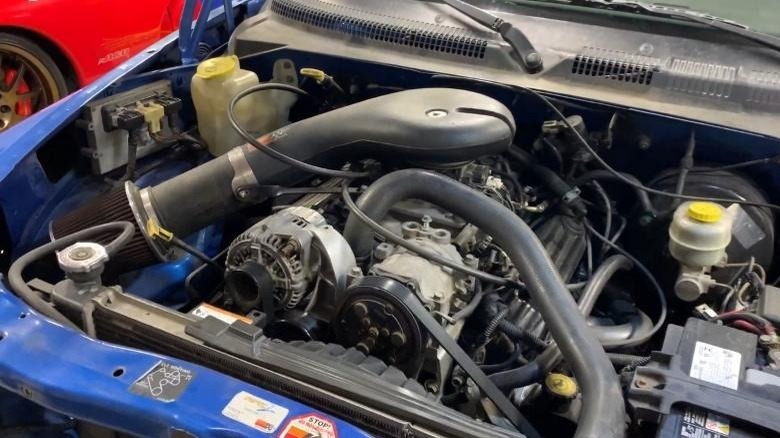Is The Dodge 5.9 Magnum A HEMI Engine, And Does It Matter?
The Dodge 5.9 Magnum is one of Chrysler's most popular V8s. It was released in 1993 as a redesigned version of the 360 cubic-inch (5.9-liter) LA series and, among other things, brought revised cylinder heads, intake manifolds, fuel injection, and oil seals. As with the other Magnum engines, those changes were meant to make the 5.9-liter Magnum engine compliant with the even stricter 1990 Clean Air Act emission standard, which was applicable to all new vehicles from 1994. The original 5.9 Magnum had 230 horsepower and between 325 and 330 lb-ft of torque, but midway through its production run, its output rose to 245-250 hp and 335-345 lb-ft of torque.
Despite the Magnum engine's direct links with the LA series, the distinction between the two is not always clear to everyone, so people seldom wonder if the Dodge 5.9 Magnum is a HEMI. The short answer is no; the Dodge 5.9 Magnum is not a HEMI but an updated version of the Mopar LA Series V8 engines first introduced in 1964. In fact, the Magnum 5.9 was eventually pulled from the market in 2003 to make way for the third-generation HEMI engine, beginning with the 5.7-liter version, which Dodge discontinued to create room for the Hurricane engine because of the ever more stringent environmental obligations.
Does it matter that the Dodge 5.9 Magnum is not a HEMI engine?
That the Dodge 5.9 Magnum is not a HEMI only matters depending on your goals. The 5.9 Magnum is not as powerful or efficient as the third-gen HEMI engine (although the difference in fuel economy was negligible back in 2003). As a comparison, the initial Gen III HEMI 5.7 engines made between 335 and 345 hp and 375 lb-ft of torque in Ram trucks and Jeep Grand Cherokee. That's already 95 extra hp and 30 more torque than the most powerful Dodge 5.9 Magnum engine. That difference is even more significant when you weigh the Magnum up against the more powerful HEMI engines, such as the Dodge Hellcat 6.2-liter V8 D170, which makes an astounding 1,025 horses and 945 lb-ft of torque under the hood of the 2023 Dodge Challenger SRT Demon 170.
As for the HEMI engine's fuel economy, a 2003 Dodge Ram 1500 with a five-speed automatic transmission achieved 13 mpg city, 17 mpg highway, and 14 mpg combined, according to EPA estimates. In contrast, a 2003 Dodge Ram 1500 with the 5.9-liter Magnum engine mated with a four-speed automatic returned 12 mpg in the city, 16 mpg on the highway, and 13 mpg combined. While initially, the difference between the two engines was barely noticeable, later HEMI versions proved to be much more efficient. For example, in EPA testing, a 2022 Ram 1500 with the 5.7-liter HEMI engine and eight-speed automatic transmission gained 18 mpg in the city, 22-23 mpg on the highway, and 19-20 mpg combined. So, given the increasing emphasis on moving toward a low-carbon society, it might matter that your next engine isn't very efficient. However, if you're just after a relatively affordable, tried-and-true powertrain that works, then less so.

